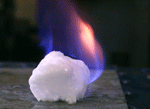Ingo Pecher
Why study gas hydrates?
 |
"Burning ice": Melting gas hydrate releases methane (from http://www.fossil.energy.gov/programs/oilgas/hydrates/index.html, last accessed 16 Oct 06) |
Gas hydrates are present in vast quantities beneath the Earth’s continental margins and permafrost regions. The amount of carbon stored in gas hydrates is thought to rival that in fossil fuels, whereas the amount of methane locked in gas hydrates is three orders of magnitude larger than that currently present in the atmosphere (Kvenvolden, 1988; Kvenvolden, 1993). Gas hydrates are of major promise - and concern - to the Earth Sciences community:
- Energy source: Gas hydrates may constitute a major source of natural gas. Methane is not only the most CO2-efficient hydrocarbon, it is also often considered a significant step towards a hydrogen-based economy because it can be used in fuel cells. Subsequently, several countries, including Japan, India, South Korea, China, Taiwan, and the USA, have embarked on significant research into the viability of methane hydrates as a future source of clean and CO2-efficient energy.
- Seafloor stability: The dissociation of solid hydrate to gas and water in marine sediments is thought to weaken the seafloor (Booth et al., 1994; Mienert et al., 1998), which causes great concern among geoscientists and offshore engineers alike: Melting of hydrates following warming of ocean currents in the future may trigger submarine landslides. More immediately, production of warm hydrocarbons through gas-hydrate-bearing layers may lead to hydrate dissociation and borehole collapse (Moridis and Kowalsky, 2006).
- Feedback for climate change: Gas hydrate stability depends on pressure and temperature. Future temperature changes are therefore bound to lead to gas hydrate melting. The response of the gas hydrate reservoir to climate change however, is still poorly understood. This question may be particularly urgent in the permafrost where pockets of dissociating hydrates have been encountered (Yakushev and Chuvilin, 2000; Yakushev, 2004). These so-called meta-stable hydrates may be in a state of dissociation after temperature changes at the end of the last ice age and may already be releasing methane, a potent greenhouse gas, into the atmosphere.
Perhaps most importantly, gas hydrate is a common substance in the seafloor and the permafrost that we still know very little about.
Further information on the significance of gas hydrates can be found at:
- U.S. Department of Energy, Gas Hydrates Program
- U.S. Geological Survey, Gas Hydrates Research
- JOGMEG’s (Japan) gas hydrate research
References:
Booth, J. S., W. J. Winters, and W. P. Dillon, 1994, Circumstantial evidence of gas hydrates and slope failure associations on the United States Atlantic continental margin, in E. D. Sloan, J. Happle and M. A. Hnatow, eds., International conference on natural gas hydrates: Plenum Press, 487-489.
Kvenvolden, K. A., 1988, Methane hydrate - a major reservoir of carbon in the shallow geosphere? Chem. Geol., 71, 41-51.
Kvenvolden, K. A., 1993, Gas hydrates - geologic perspective and global change: Rev. Geophys., 31, 173-187.
Mienert, J., J. Posewang, and M. Baumann, 1998, Gas hydrates along the northeastern Atlantic Margin; possible hydrate-bound margin instabilities and possible release of methane, in J. P. Henriet and J. Mienert, eds., Gas hydrates; relevance to world margin stability and climatic change: Geol. Soc. Spec. Publ., 137, 275-291.
Moridis, G. J., and M. B. Kowalsky, 2006, Response of oceanic hydrate-bearing sediments to thermal stresses: in Proc. 2006 Offshore Technology Conference, Houston, TX, 18193 (19 pp.).
Yakushev, V., 2004, Intrapermafrost gas hydrates at the north of west siberia: in Proc. AAPG Hedberg Conference, Vancouver, B.C., 4 pp.
Yakushev, V. S., and E. M. Chuvilin, 2000, Natural gas and gas hydrate accumulations within permafrost in Russia: Cold Reg. Sci. Tech., 31, 189-197.

